Chilling photos of for-lease signs lining the Great America Parkway
There are parts of Silicon Valley where commercial real estate is still hanging on, and there are parts where it has let go.
In Santa Clara, it has let go. Overall availability of office space in Santa Clara was nearly 19% in the first quarter, according to Savills Studley, up from 14% a year ago. Only two other areas in Silicon Valley – Milpitas and North San Jose – show greater availability at respectively 23% and a harrowing 30%.
The availability problem becomes very real along the Great America Parkway, between Highway 237 and Highway 101. It’s near Levi’s Stadium. Nearby, Yahoo owned 49 acres of land that it acquired in 2006 and on which it had planned to build its new headquarters. It tore down the buildings on it and got the project approved for 3 million square feet of office space. It scuttled these plans in 2014 and turned the land into a parking lot for Levi’s Stadium. In April 2016, Yahoo sold the property for $250 million to LeEco, a Chinese company that had surged out of nowhere.
LeEco was going to get into nearly everything, including electric cars in the US. It was going to build its global headquarters on it and hire 12,000 people. Then came reality. Earlier this year, LeEco in turn scuttled those plans and pulled back from the US, claiming that it had run into a cash crunch. It has since been trying to sell the property. There will be a buyer eventually, as always, but maybe not at $250 million.
Turns out, that corridor along the Great America Parkway is drowning in office space that is for lease.
“A growing Commercial Real Estate disaster” – that’s what Michael, who has been to this area on a regular basis since 2010, calls it.
“This should be a thriving area given it is directly in the path to Levi stadium,” he said. “I have been seeing an incredible amount of construction here and everywhere over the last few years. However in the past year, I am seeing a considerable amount of for-lease signs with new construction projects unabated.”
Here is the stretch of the Great America Parkway between Highway 237 and Highway 101:
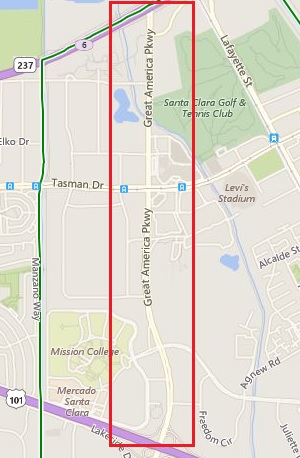
And here are the for-lease signs Michael photographed in front of office buildings along the Parkway.
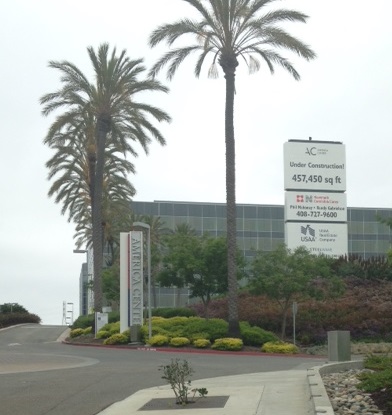
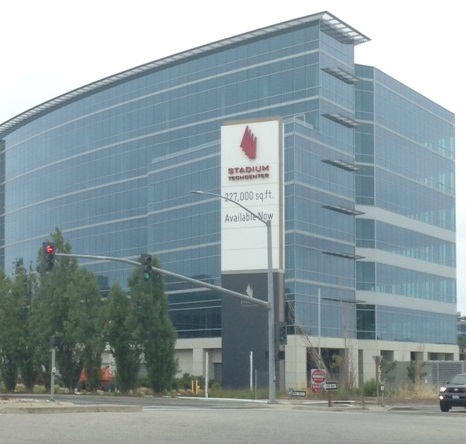
The building below used to sport a Dell logo. The logo disappeared, and now the whole building appears to be under renovation.
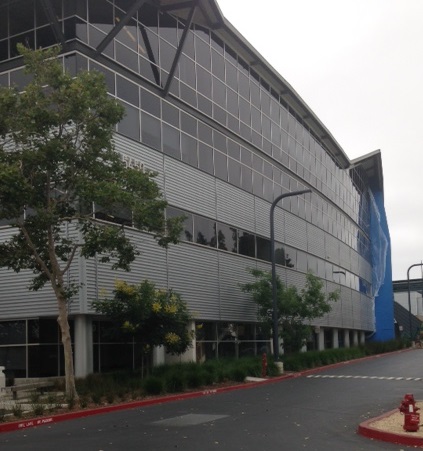
The building across the street now has the Dell logo:
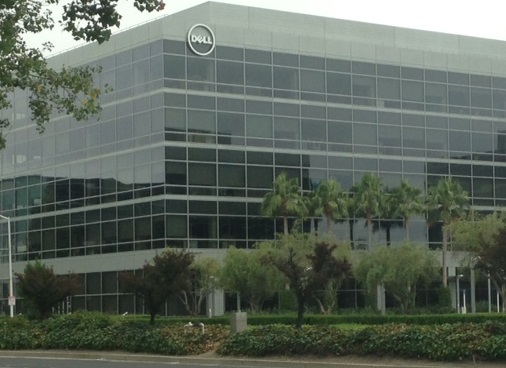
And more space for lease.
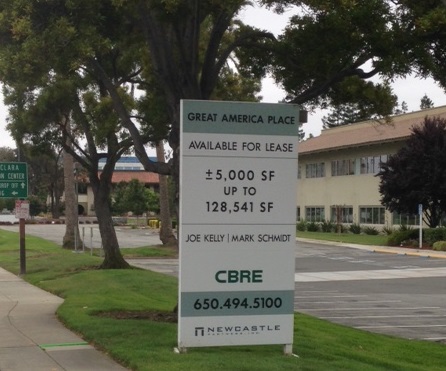
“Santa Clara and Sunnyvale had some of the most pleasant industrial commercial buildings that blended well with curved roads and lots of trees,” Michael says.
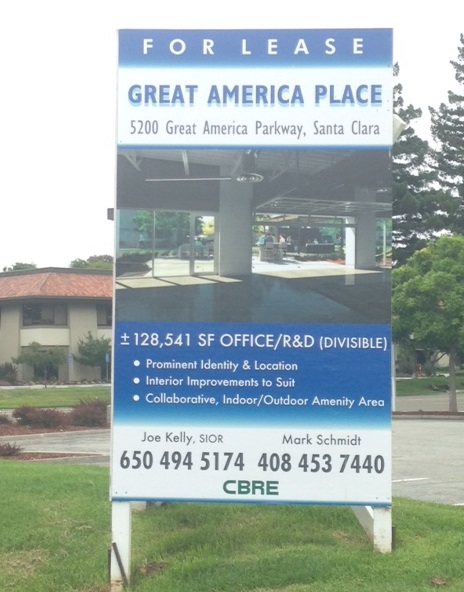
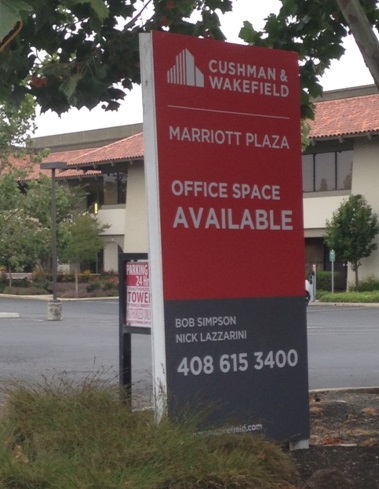
“Now most of these are being leveled for these glass multi story monsters.”
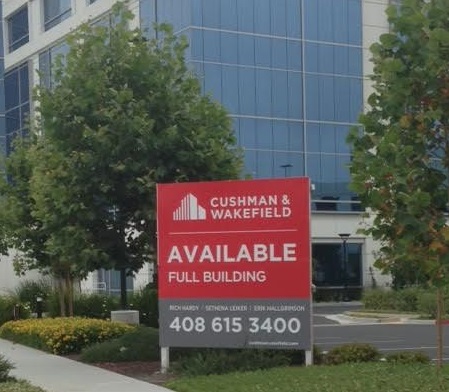


“There are at least a million square feet of unoccupied commercial real estate on a single street.”

“Irrational construction?”
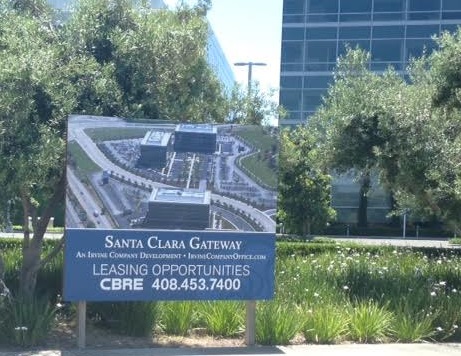
But it’s not just Santa Clara. According to Savills Studley’s report on the Silicon Valley office sector in Q1, overall availability in Silicon Valley rose to 16% and availability of Class A office buildings jumped nearly four points year-over-year to 20% in Q1.
In some areas, availability is low. But in others, such as in Santa Clara and San Jose, the opposite is the case. These two cities account for nearly two-thirds of the available space for lease in Silicon Valley. And there is a lot of construction, but only about half of it has been pre-leased.
Availability in some key places:
- Palo Alto: 6%
- Menlo Park: 12%
- Mountain View/Los Altos: 12%
- Downtown San Jose: 17%
- Santa Clara: 19%
- Milpitas: 23%
- North San Jose: 30%
Yet, overall asking rents rose 6% year-over-year. Class B and C asking rents were about flat, but class A asking rents spiked nearly 15%. Even in Santa Clara – despite the vacant offices cluttering up the landscape – overall asking rents rose 5% year-over-year.
But these are asking rents, not actual deals, where tenants negotiated big concessions and lower rents. And these deals have slowed to a crawl…
Leasing activity peaked in mid-2015 at 12 million square feet on a trailing four-quarters basis. Leasing activity has since plunged 50% to just 5.8 msf for the trailing four-quarters, even as new supply keeps piling on the market.
“It is open to debate, though, whether the region is gearing up for more growth or if the rally is winding down,” the report mused.
And nationally, the Commercial Real Estate boom-and-bust cycle has turned. Read… Next Asset Bubble Cracks: It’s so Big even the Fed is Fretting
Enjoy reading WOLF STREET and want to support it? You can donate. I appreciate it immensely. Click on the mug to find out how:
![]()


Same in UK. I live around M4 corridor. There are tonnes of free office spaces vacant since 2008. There is one big giant building used to be Honda head office and it is vacant for nearly 3 years. The offices space used to be owned/rented by Sun microsystem near Camberley and M3 corridor still vacant.
The empty office building next of my office have been rebuilt for residential flats. Expect this trend to pick up. A flat can be sold within a month. Imagine all these vacant office spaces eventually become cash strapped and have to face the reality to rebuild again for residential purpose.
There is a load of class c and b offices in central london that will end up being converted into apartments, just not ones priced in millions.
http://denariifin.blogspot.co.uk/2017/06/could-class-well-let-cbd-major-city.html
-50% price falls are my forecasts
changed the blog address/ name
http://strategicmacro.blogspot.co.uk/2017/06/could-class-well-let-cbd-major-city.html
At the London end of the M4 they just gave up on offices, almost every building is now converted into housing.
Then again many of those luxary flat stand empty, perhaps £1/2M to live in Brentford within spitting distance from the M4 isn’t a great idea.
Maybe we are seeing the first signs of Silicon Valley going down the path of the Rust Belt ? Consider what have come out of Silicon Valley during the last decade and add the fact that hot spots for technology developemnt around the world and in the US too. It will be interesting to see what will be left of today’s Silicon Valley the day the inevitable downturn appears in the economy.
Surely the end of cheap money will be devastating for silicon valley. Investors might stop throwing endless cash to unprofitable companies… and that is going to hurt, a lot.
Agree, companies like Uber will very quickly be toast without the cheap money they depend on to finance their large operating losses.
Uber and Lyft just got a huge client, the US govt. They can now be used for official business travel.
“Consider what has come out of Silicon Valley the last decade”
Interesting you ask, given its the 10th anniversary of the iPhones release. They’ve sold what, over 1 Billion devices and generated over 1 trillion in revenue, and still sell around 100M iOS devices a quarter? iOS developers are making $30B a year?
And then there’s Android, which is over 2 billion devices sold.
Yep, been pretty slow decade for Silicon Valley.
What else?
Well, to start with, the following have about $100B in market cap (it would help your credibility if you did your own research):
Uber
Lyfy
Arista N/W
Box
Chegg
Cloudera
Evernote
IMVU
ODESK
Plantir
Survey Monkey
Uber, lyft?
Dude that is exactly what we were saying. These companies would have never survived but for the distortion created by ultra cheap money.
And the other ones.. I do not know them, but I am pretty sure that they must have PERs above 100.
The point being: this is not sustainable, and as soon as investors demand that these companies play under the same rules as everyone, the house of cards will collaps.
And about my credibility… I do not really care. I do not have to convince anyone. Go ahead and buy uber shares if you feel like it.
Two big companies don’t make the whole Valley. And both Android and Apple are global companies that would survive perfectly fine if they closed their offices in the valley and moved them somewhere else.
raxadian
I think I understand the list of your comment, but Apple & Google have a huge impact on Silicon Valley. They could locate elsewhere, but they haven’t. They also serve as beacons for generations of .com experiments.
Since 2015, Silicon Valley venture funding has “fallen” to about $25b/yr, which is reported to be less than a couple other tech areas (LA being one…). Valley funding goes up…Valley funding goes down. Depends on what’s for sale.
If Silicone Valley tech wealth generation ever dried up, CA would quickly start to look like a third world parking lot. 145,000 of CA’s 40,000,000 residents (mostly tech & Hollywood) pay 50% of the state’s total personal income tax
Excellent point, most locals in the valley, don’t realize that. I plan on getting out of the area before things go further south. Possibly Texas.
Interesting interview on Peak Prosperity about the increasing costs of complexity along with its diminishing returns.. Data shows that the more complex a system gets, the more energy, human and physical, that it takes to gain the next innovation. https://www.peakprosperity.com/podcast/109453/joseph-tainter-collapse-complex-societies
What is showing up here could be that the benefits are starting to out pace the costs.. Not only in the cost per square foot for the space to do the research but the cost of investing to get that RIO.
I watched that when it came out. It was a very interesting interview to say the least.
From that podcast, we see why nothing is ever really fixed in our complex society, just papered over:
“And so individuals need to take responsibility for their own ignorance. As I said, our species did not evolve to think broadly in terms of time and space and if we’re going to maintain our way of life, people have to learn to do so. People have to take responsibility for knowing and understanding the predicament that we’re facing.”
Sorry, too busy tweeting photos of their lunch on their iToy…
2nd law of thermodynamics: entropy (disorder) can only increases (e.g. no such thing as perpetual motion).
You obviously never worked or lived in Silicon Valley. In the early ’90’s there were many see through buildings. Again after the 2000 crash and again after 2008 crash. Each time the real estate was absorbed and then expanded. I don’t know how but it was, and I witnessed it.
I think we are at the top of the S-curve, for much of software and tech, but I have been wrong before. The Bay Area still provides the technology engine for the world. Texans have been waiting for CA to fall like they did in S&L scandal in the mid 1980’s. It has never happened for any length of time. I think SF will have problems, but likely rents will fall greatly and there will be absorption. It won’t be until we have real inflation prolonged that this area will begin to have problems in spades.
CPI of San Francisco Bay Area Inflation is 3.8 period ended April 2017. People can’t afford to live here and others are moving out. Seen these adjustments since the 1970’s. All equal out
Interesting comparison. Although I don’t see San Jose becoming the next “Detroit of The Future” anytime soon, it is a one trick pony. Meaning that, like Detroit in the 50’s & 60’s, San Jose doesn’t do anything else except tech. San Francisco on the other hand, even with FB and Twitter offices moving in etc, has it’s number one economic driver being Tourism and the accompanying service industry. Twas thus before 2000, and will probably continue to be as long as we have cable cars and pretty views. Any downturn, outsourcing etc in the SV economy will leave the entire city an empty parking lot- because why the hell would anyone be there if not for Tech?
– Do you have an estimate of how much (e.g. a %) of that office space was added after say 2008/2009/2010 ?
– It’s the psychology of “rising prices” and that leads to more (credit) growth.
The office vacancy rate for Calgary (in Canada) was reported as being near 25% last September.
http://www.cbc.ca/news/canada/calgary/calgary-office-vacancy-25-percent-july-remax-1.3781916 . And yes, there’s talk of converting some of those towers to residential condos, too.
Wolf. On another subject I read recently that FiatChryslerRam now has less than 1% market share of the American automotive marketplace. Could this be true?
The number to look at is its market share in the pickup segment.
Ram sales account for about 19% of the total pickup market, compared to the F-series with a 31% share. So not great, but Rams are hanging on.
Seems that in May 2017 the Ram outsold the Silverado by a little over 1,000 units.
Any idea as to why that came to pass??? I wonder if that will continue for June.
IF you consider ALL the pickup models that GM produces – Silverado + Sierra + Colorado + Canyon – – Ford still whipped them.
FCA propaganda plain and simple
FYI the Ford F150 and its derivatives have always been the number one selling full sized P/U
If folks start acting rationally about trucks the Big Three are all in trouble. The question is why a machine that is supposed to be for work and therefore operated until it is not economic, in fact gets replaced more like women’s shoes.
The load factor of the trucks where I live is less than 5%. It may be 1 or 2%. The rest of the time the box is empty but the owner thinks: “I’m driving a truck!”
And if oil WAS to recover to, say, $80…., disaster.
The % of vacant commercial space has risen because the actual available commercial space has increased.
So if the red tiled offices are gradually replaced by glass monsters, you are at least quadrupling the space.
Demand may not be rising in the same ratio. So, while RE may reduce commercial property rates, it does NOT indicate that the SV economy is crashing.
It just indicates that there is over capacity in commercial RE.
No `Rust Belt`. Yet or maybe never.
Good point. Thanks for that.
Folks in rust belt thought the same one time..
Real estate bull thought the same one time before 2009 crash..
Absolutely correct. Have you seen Nvidia?
Never (a rust belt) is more like it. IMO, the driver of future growth will be tech — just look at how Internet ensured that most people get something out of it. The next wave of tech will be in Bay Area in 2 to 4 years after a crash. For now, RE is like fiber cables they laid in 2000; we only started using the capacity some 10 years later.
To plagiarizer Gertrude Stein: A bubble is a bubble is a bubble…
Obvious answer is to prohibit “to let” or “for sale” signs because of the contribute to public unrest.
Realistic answer, in hindsight, is for the planning and zoning agencies to be proactive, and do their own market analysis/projections, and refuse building permits for obviously non-viable projects, particularly those that would involve the demolishing of existing occupied and taxpaying structures.
Anyone know if Santa Clara and the other municipalities have made contingency plans for when the bubble pops, as they always do. How much have the municipalities borrowed to help inflate the bubble, and are multiple municipal bankruptcies likely as a result?
“Realistic answer, in hindsight, is for the planning and zoning agencies to be proactive, and do their own market analysis/projections, and refuse building permits for obviously non-viable projects…”
Because everybody knows that government bureaucrats understand the commercial real estate market better than anyone. ?!?
The real solution is to end the FED.
Marty I second that proposal
Putting Planning in charge of deciding which project goes forward and when is an awful idea. Sounds like a great set up for bribery and corruption.
But reigning in the TBTF institutions, curtailing the creation of derivatives and re-instating Glass-Steagall would be a great start. Putting some sound regulations in to public pension funds and their unfunded promises might also help bring some integrity back into the system. I mean, someone has been buying all these CRE MBS.. The banks don’t just have all this debt on their books against their meager deposits. I hope. And without the Derivatives to bind the paper mache all together, it would just be a huge pile of garbage.
Credit is just to easy to create and the incentives are for creating more with few consequences for exuberance. Local governments benefit in higher property tax incomes. State and federal governments benefit thru the taxes collected from the workers who make the cement, steel, glass, and everything else that goes into unneeded construction. Just look at China and how it’s GDP has been pushed up and up by building infrastructure that will never be needed. Same here in the US.. Everyone is happy while the house of cards is built.
Problem is in the end, someone is suppose to repay the debts. If anyone wants to see what’s coming, just look at Illinois. Proposed 32% tax increases and probable failure of their pensions.
And everyone knows local government elected officials are deep in the pockets of land developers.
Probably have their employees pensions neck deep in REITs too. Am I the only one that finds that this is occurring around the Great America Parkway? Maybe they should rename it to the Broke Ass America Parkway.
RE: Because everybody knows that government bureaucrats understand the commercial real estate market better than anyone. ?!?
—–
Years ago, when the banks put their own money into these developments, the more prudent bankers acted as a damper on “animal exuberance”/bubbles. Now the loans are not retained by the bank, but are “monetized” as mortgage backed CDOs, and sold on.
Your are correct about the bureaucrats not understanding the CRE markets, but it is no great feat to project the office space needs for the city over the next 5 to 10 years under several economic scenarios, and plot the trend lines.
It is also not rocket science to calculate the existing office space, add on the new [building permit] office space, and subtract the demolished office space to establish another trend line. If the total permitted office space is then above that projected/needed under even the best economic scenario, it would seem prudent to deny the permit. Perhaps the “best scenario” trend line is not the one to use, but the median or most likely trend line, and the developer can go to court to prove why they should be allowed to build.
Indeed, to minimize the blighted areas created by unsustainable/impracticable/unnecessary development, resulting in parking lots, derelict buildings [either going up or coming down], and a destroyed tax base, it may be a good idea to require a completion bond from the developers before a building permit is issued.
It is also well to remember that even if there is no direct investment by the city in these office projects, such as economic development or revenue bonds, there are still substantial obligations/investments by the city in infrastructure/personnel, and possibly tax abatements, taxing districts, and/or tax increment financing, and it is only a matter of time before interest rates return to normal [or possibly above].
Yours is one best comments I’ve read on this blog – an erudite fellow. Here’s the real issue. Markets, by their nature, have wide price fluctuations. Real estate owners look at markets real time and have a feel for things well before they show up in trend lines many months later. By delaying permits until a trend line confirms those angry developers calling the city ‘anti-business’, political pressure will force the policy to change. Markets have to allow winners and losers. Some of the empty office space will get bought very cheap. New development will accurately reflect the local economic situation. Sorry, but centralized control has never worked.
“Centralized control has never worked.”
Control is always centralized. Either in an somewhat accountable government or in wall street. But there is no such a thing as a unplanned economy.
Hiho,
now YOU’RE an erudite fellow! :)
My little knowledge of planning/zoning guesses that the idea of being proactive would require a lot of work. Difficult work because it would require something close to prognostication. The risk would become the city’s.
As for contingency plans I would be shocked if they had a plan that was well formed/complete. More likely that they will raise sales tax and start mumbling about pension funds.
But we have to remind ourselves to take our daily red pill and recall that ultimately it’s funny money so it comes down to who has a place to sit when the music stops. Will it be the municipality or the holders of comm. real estate?
This is actually not new in the Silicon Valley as they have had multiple office spaces available for the past decade.
The two primary reasons are the cost for lease space, term and conditions of the lealease and many of these structures were built as designed to build sites for various companies that cannot in any way be split, redone or changed at all in any way.
That’s the real problem and the commercial leasing agents hands are tied by rules and regulations of the counties and the state.
Doesn’t knocking down a building and putting up a new one reset the Prop 13 tax basis?
Those old offices were probably paying tax on 1976 valuations.
Only IF they were under the same ownership.. And was Prop 13 just for residential or did it include commercial.. I’m thinking only residential.
I didn’t think prop 13 applies only to residential property, though residential property was the poster child as I understand it. People were concerned/angry about being priced out of their own homes by increased property valuations and thus greatly increased taxes over time. Especially for people on fixed income or retirees, etc, it was a huge concern with rapidly escalating property values.
A quick Google shows it also applies to commercial property. http://www.evolve-ca.org/prop-13-facts/ The site may be pushing a certain viewpoint, but says, “Because homeowners move on average every ten years, and commercial property rarely, if ever, changes hands, the tax burden in California has shifted decisively onto residential property owners. Before Prop.13, residential accounted for 55% of the property tax and commercial paid 45%. Now residential shoulders 72% of the tax burden while commercial only pays 28%.”
Commercial owners may hold onto property longer because they don’t need to sell to move for work, retirement or other personal reasons. Also, corporations don’t have the limited lifespan of people so they can hold onto property like vampires to avoid the sale of the property that would trigger a revaluation to market rate.
Interesting about commercial property not changing hands. I can see that with an oil refinery but what that article says is that even the strip malls and shopping centers seldom change hands.. So those who built them 30 years ago still own them and have rented/leased them out for all these years?
And all those apartment complexes? What about depreciation? Wonder how that fits in to all this?
Yet the newer building must be costing the owners a fortune in property taxes..
It is all so complex isn’t it.
Commercial also. Intel has been one of the biggest beneficiaries. Huge campus, pays almost no property taxes in terms of current dollars.
Commercial buildings are seldom sold in California. The corporation that owns the building is sold.
Suzie “Commercial buildings are seldom sold in California. The corporation that owns the building is sold.”
Pretty big loophole I’d say!
We don’t ned no steenkin’ plan! We can akways tax SOMETHING!
Gummerment folks making the decision for investors to spend money to build or not spend the money to build??
They will either refer to the same data that the investors do – and arrive at different results – – or have endless hearings before hustling the investors into making bad moves (because they can)…
The BANKERS should make the decision to lend or not lend – based on the info they have to look at.
IF it is a ALL CASH build – the losers are the project investors – and the current property owners that watch the over saturation kill their rent profiles…..
” To plagiarizer Gertrude Stein: A bubble is a bubble is a bubble ”
Its not plagiarizing if you’re giving credit .. its quoting .. or paraphrasing
Wolf, if i repost your article somewhere on social media, what part of copy/paste is considered fair, before i post link to your originsl article?
You can post two or so paragraphs and link to the article. Everything is copyrighted on this site, including the photos. So please do not re-post the whole article and the photos. Thank you.
Thats why i asked, thanks
It is likely Santa Clara rubber stamps any construction presented to them. I do not live in SC but I am sure that the potential fees and taxes these is irresistible. These builds are a blight.
The traffic has gotten very difficult and the addition of the stadium has not helped here. I could not imagine the grid lock if these buildings were actually all occupied.
This is a sign of malinvestment and as Wolf indicates a sign of stress. The overcapacity puts downward pressure on rents which will put a strain on the owners as their margins evaporate. I am quite sure these projects were very expensive and the investors were expecting a high ROI to make these projects work.
Once we reach the end of the business cycle this situation is only going to get worse. I hear the clock ticking in the background.
I was in the Raleigh NC area last year and noticed entire blocks of retail/commercial space for rent They were almost exclusively new builds in the last 3 or 4 years and sitting empty or with maybe a collectible car stored in a 2000 SF space or some other underutilized situation
I’m no financial or real estate whizz kid, just a 71 year old BBC (Born Before Computers) pensioner, so what would I know about technology?
Well…try this for common bloody sense: Who in his/her right mind would go to the trouble, not to mention expense of actually renting an OFFICE, with a lease of course, when 95% of admin in the 21st century can actually be done on a simple laptop or smart phone on the boot, trunk if you are Murican, of your car.
Jeepers have I STILL got to think for everyone nowadays? Especially those self-appointed brainiacs at Silicon Valley.
Dave,
I chuckled at your comment. I am a 61 year old version of the same description with the same POV. :-)
Yesterday, I spent about 2 hours building a better mousetrap. Honestly. For some reason, this year on Vancouver Island there is a population explosion of mice. There also seems to be a lag of predators. There are a few options available for people. A person can buy the old fashioned USA made spring trap for a buck, an $80.00 electric zapper which had to be invented at the San Quentin zap room, poison, or use a fancy digitized frequency repeller/emitter. Anyway, while working I mused on the iphone 10 year anniversary and how so much hype and finance was simply a reconfiguring of the same insightful product. I don’t own any of these new devices and certainly do not plan to ever buy one, but as I worked away on my device I compared it to the age-old spring trap unchanged in almost 100 years, and most likely made at the same PA factory.
Honestly, I think the analogy holds, that the tech surge is now on the wane with only unicorn copycats and desperate investors searching for yield, wealth, and fame. If debt was available at realistic rates, how much of this fluff would even exist, let alone thrive? Thus, empty corporate office space and a bubble waiting to blow.
My mouse trap is not a new idea, in fact I made one over 30 years ago to catch mice at a remote fish hatchery that we shut down for weekends. Mice come in groups, at least pairs and they dart around towards food in fast little dashes. With my new trap they run up a small incline, and dart across a colored plexi-glass ramp towards a gob of peanut butter. Of course, the ramp is really an axle which rotates and drops the mouse into a bucket of water, self-corrects, rises up and lies in wait for the next brave forager. It works!
Will the new great thing to change everything we do likely be based in CA tech land? Probably not. Will it be digital? Who knows? Really, ones and zeros are now just tools; a modern wheelbarrow or shovel. What do people really need?…right now.
Here is my list:
* affordable housing solutions minus regulatory costs/inflation.
* affordable transportation solutions
* meaningful employment with human interactions
* fair reward for hours worked
* less corporate domination and collusion with Govt
Sounds like collapse and a reset, to me. :-)
I spent 17 years teaching high school. I have yet to meet a parent that did not want their child to go to university. Nowadays, that means huge debt starting out and dubious prospects. The latest push is for coders….not doctors. Everyone just has to at least take a coding class and learn the basics. When I think of quality of life, somehow sitting at a screen all day in competition with visaed 3rd worlders who will do your job for 30% of what you need does not seem like a good idea. I’m beginning to think when the herd turns left, maybe going right or turning around makes more sense.
When digital slavery is exposed for what it is, people will not stand for it.
As for better mousetraps? I have a niece who is 39. She, and her husband who grew up in rural Nebraska and should know better, also had a mouse problem. Their solution? Well, they didn’t know what to do and wouldn’t handle ‘icky’ stuff, anyway. They signed a contract with an exterminator who once every few days came out and reset traps for them and disposed of the carcasses. Did I mention these young folks are in debt up to their eyeballs? What’s next for them, a self driving car?
I hear this but complex software development simply isn’t being done by cheap 3rd world developers. Actual software developers all over the world get paid exceptionally well.
It’s true there are cheap hourly coders from India. But they can’t write anything complex or maintain a system for you. The educated developers in India still get high pay. Same goes for China and every where else.
The only risk to techies is a crunch for demand in new fad technologies. And the massive layoffs we have seen as big companies put old technology into streamline mode. Literally every major old tech Corp, Intel, cisco, HP and TI, Qualcoom and Microsoft have had massive layoffs and restruntiring over the last few years as aged technologies no longer growing sheed their excess enigneers.
Tech sector jobs like software, hardware and security aren’t going anywhere anytime soon. Though different sectors of those markets will have different pools of workers.
And as others have noted location really is unimportant in the traditional sense. You can easily have software being worked on from cities all over the world with no strong advantage to consolidating them in any one place.
are you a software developer?
I am a software developer and I can say that software development skill has been commoditized for better or worse
It has increased the living standards for coders in India but at the same time decreased it a lot for American
Regarding developing completed software… the amount of jobs needing this skill set is very very low..
Most of the coders needed have generic run of the mill skill set requirement ..
I am living in the trenches seeing it first hand.
jon: I totally agree that software development has been commoditized. These days most software, specially the kinds that large corporations use are gigantic mesh of different software where each developer knows about and write software for a small portion of it. Very few developers need to know about the whole monster. Thus you can hire people from India to do the job for a fraction of what you pay to an employee in US to do that job. We are living in US and have to pay the living expenses in US, but we have to compete with people in India who consider $10,000 a year to be 10 times the average salary in India.
It’s been discussed here before how putting in 60-80 hours a week for a job that is supposed to be a 9-5 job is normal for software developers; and of course don’t even think of over time for even one hour of that 20-40 hours extra that you have put int. Software development is just higher price slavery these days.
The probability of making decent money, the legendary $100k+, as a coder is about the same as that of going into writing jingles for Tin Pan Alley and making it big. Sure there are the Gershwins and so on, but for the average person, Meh.
Go into it if you love it and would not mind poverty, to be able to do it. But don’t count on “tech” to provide you a better living than you’d get driving a forklift.
I guess I’m one of those gershwins, and I’m far, far away from Silly Valley and often work from home. I got into software back when it was called computer programming and it was reviled by society as a pointless pursuit done by basement dwellers. But I was a math guy who saw that everything would eventually be modeled in computers so I figured I better learn as much as I can about them. The math side has definitely helped insulate me from a lot of the competition in software. I still think there are tremendous opportunities going foward – drones, computer vision, software to model complex systems and 3d printing. But you have to be good at the core stuff (math, comp sci and really logical thinking which is in short supply) and have a good work ethic.
On average a plumbing career will outperform an IT career.
Of course if the guy wants to become a millionaire, he will have to have his own outfit with a least a few employees. Very low capital needed compared to opening a restaurant, which by comparison is a suicide plane.
But $ will never be as quick as some coding ‘gamer’ type scores.
And unlike uni student loans, he earns while in the apprenticeship.
I run/own a SW contracting company in the PNW. (~34+ years programming computers.) Our experience is that senior SW developers are in very high demand. My clients are constantly complaining that they can’t find qualified SW devs… At *any* price. Believe me, they *will* pay, if they can find qualified people.
We sell our services world wide. (Yes there is a difference in foreign -vs- US companies. Big US is all about price, foreign is what can you do and when. For them price doesn’t even come up until the end of the negotiation.)
So to some extent this is like the blind men trying to describe an elephant.
This year we pushed rates again. Mostly because I only want to work part time, and high rates cut down on the make work jobs. W2 wages last year for our employees ran between 180k to 250k.
We are turning down business now, but I can see a softening in the market. So I’m expecting the tech economy to slow down over the next couple of years. Which, as a contracting house is actually good for us.
RangerOne,
I agree Software has become a line item on a balance sheet, and while the short term gains to corps are good ($ not paid, and the ever popular immobile work force,) the change has not been good for anyone. It’s just going to take the corps a few more years to figure this out as systems scale up even more and performance tanks.
The cheap coders from Asia have not only stagnated wages for the last decade, they’ve also degraded source code to the point of poor performance and mountains of spaghetti code. Poorly documented (if at all,) thousands of lines long, and more cut/paste and get out quick code than ever.
I am hired to do complex coding and I agree that skilled coders will always have work, but unless I do end-to-end design/development, I now spend more of my time consolidating code and improving performance of the outlying code written by the “run of the mill” coders than what I was hired to build.
I also agree that with a small talented team, better performing, elegant, longer lasting software can be produced in a faster time line.
For the last ten years I have said that if C-Suites, Sr management and finance actually knew how to code, they’d run screaming if they ever looked at source code libraries.
I’m East coast, but I can’t imagine software development is any different on the west coast. Too many of the variables have the same data.
Exactly.
I really liked your #2 point — “affordable transportation solutions”
because it is based on hard science, and it’s why I think Amazon is just Scamazon.
(the other list points are just wishful thinking though)
Internet sales are increasing carbon dioxide pollution. Trucking and Distribution simply is burning more diesel.
Paulo, be sure to post your trap in action on YouTube along with all the others: https://www.youtube.com/watch?v=UI8l8f7XVNM
I feel your pain Paulo. I live in a country (South Africa) that has a REAL unemployment rate of 50% and the media and radio are full of BS ads for the Youf to go out and ‘start up’ an APP venture. Holy smoke, like there aren’t ALREADY about 2 gazillionmillon apps out there and all DEVOURING airtime and battery life as well.
Here’s a more PRACTICAL slice of advice: ‘Cut the damned birth rate youfs’ they can’t employ the work force they currently have and you lot are bringing more and more human photo-copies on the planet. Jeepers am I the only adult in the room?
This just in: South Africa just LOST 48 000 jobs in the formal sector in the first half of 2017!
Oh, and there is a glut of office space here in my home town as well, seems to be a get-rich-quick pipe dream that is going bad globally friends.
You forgot the oldest and original “mouser”, the domestic cat!
Working from home has some interesting issues. If you live in an expensive apartment with a couple of small kids, how do you get anything done?
Working from home requires a great deal of self discipline that many lack.
Security is another big problem. You need a network connection that is fast and reliable enough so that all the work you do is on company servers and not stored on your laptop.
I personally have done a lot of work from home, but it’s not for everyone.
Most of our clients will issue their own laptop with their own VPN and required SW on it. So you just have to make sure you carry it with you on your person when you leave the house with it (on client business), and have a secure place to store it in your house/office while you are away.
Works pretty well that way, as you can keep all their IP on their machine(s).
Home is a real benefit as the commute time is zero minutes. :) Plus in the past I could sneak away for an hour bike ride in between conf calls and getting stuff done.
Works best if you don’t have to interact with their team face to face to get your work done. So it really depends on the job/team.
Drawback is that if you like the social aspect of work… It’s kind of lonely at home.
About half of our employees work from home. The company pays for a broadband connection, their computer(s), a 4k monitor and a desk chair to sit in.
Brian
I know a sr SW dev architect looking for contract work. A grey beard of the highest caliber. One you can wiki. where can he send a resume?
Dear Davebee
Indeed, lets start with the idiots at ebay that have decided if one page to show everything is great, then having you open a second page to see everything….. has to be greater. ( yea bad English) Yep, a second tab to see what was on page before. Two pages open to read what was one page. And, Show competitors items before you details are shown which used to be at the bottom of the page. Add to that advertising on TV ( I am told) says to me, it is not just bricks and mortar in trouble, but it is spreading to the online stuff. I know many sellers on ebay that are now looking at some ‘free’ sites and Amazon. Me?, I have no dog in this race.. like Davebee I am to old to buy much of anything, don’t need anything and don’t care.
Canary in the coal mine of online selling, they think they can out do Amazon. If they keep this up, they will be another RCA.
I drive 237 everyday and have seen that 225000 sqft building sit empty for more than a year. I don’t know how much longer these developers can continue to eat the carrying costs.
SF Giants Fan – I’ve noticed the Sharp Electronics office on Brokaw is empty now, and there are empty spaces down by the Old Spaghetti Factory downtown. More and more spaced/buildings are empty. No one’s moved into where DataPipe left … empty, empty, empty spaces everywhere and they’re building a ton more residential, but where are the supposed residents supposed to get work? There are no freakin’ jobs here.
Davebee,
You make a very good point and your logic is sound.
You would think that in an internet connected collaborative hi-tech society there would be limited need so such large buildings.
The commercial real estate over supply is a bet against that logic.
As long as the VC money flows from Sand Hill Rd, there will be a need for offices near by.
“You would think that in an Internet connected collaborative hi-tech society there would be limited need for such large buildings”
Michael when you look at Silicon Valley real estate you are seeing “edifice complex” in practice. The elaborate HQs were never actually necessary. They were meant to flatter the egos of the founders be it Gates, Page, Jobs, Cook etc. It’s Thorsten Veblen’s Conspicuous Consumption brought to life.
Wasn’t “Conspicuous Consumption” coined by John Galbraith?
Thorstein Veblen. If internet sales cause more truck driving, isn’t also reducing automobile miles driven? Something to think about when asserting increased carbon emissions.
I work in local government in Florida. I was just telling the County Manager a couple of days ago that there is no need for a new $50 million dollar County administration building. The technology exists right now for everyone to work from home or out of their vehicle. Why strap tax payers (myself included) with another 20 year bond to pay off? Every single form can be filled out online.
Every bond deal generates contributions for county commissioners. BTW, how many of the commissioners are associated with financial firms? I’ll bet at least one. They play you do my bond deal and I’ll do yours.
You work in government Oy Vey Isn’t that a contradiction in terms?
If you want to see sloth… Work for a big American Corporation… Most are infested with what one of my business partners calls “career cockroaches”.
The entire purpose of a corporation is to shield people from any accountability for their actions…
Your average mid level Intel, Dell, Apple, etc. manager can piss away more money with a poor decision in a 30 minute meeting, than most civil servants will “spend” in their entire careers.
Just sayin’ — based on my ~24+ years as a SW contractor working for companies big and small…
I spent 20 years working in the private sector (United Technologies, Electronic Data Systems) and 15 for County government in Florida.
My experience is that folks in both work just as hard as each other (note these are all large, bureaucratic organizations). People are going to be people, good and bad.
The private sector tends to be more efficient because they tend to have a single goal: maximize profit. Government’s goal, in the end, is to get politicians re-elected. And that means oiling the squeaky wheels.
But neither have any effect on how hard people are willing to work.
How can you expect United Technologies and Electronic Data Systems to be much different from government, when both of those companies get the majority of their revenue from government.
I’ve worked for large corporations, smaller private firms and a large public higher-ed institution. One of the large corporations had by far the worst bureaucracy and the most clueless management.
http://www.mercurynews.com/2017/06/12/google-downtown-san-jose-village-plans-swell-reach-8-million-square-feet/
The 2 laws of Real Estate globally and in Silicon Valley:
1. It ain’t over till the Chinese rolls over.
2. It ain’t over till the FAANG rolls over.
I think you mis-read the Mercury News article. In fact, it’s just going to make the office glut worse…
Google is planning to BUILD 8 million square feet, in addition to what is already there. They’re NOT going to use existing vacant space. So this will ADD 8 msf of office space, and Google might move from some of its existing spaces into the new space when finished, years down the road, and might then vacate some of those spaces.
Of course, this could also be like Yahoo, which ended up scuttling its grandiose plans.
they could be investing in real estate only , where else are they going to park their “google bucks”.
on a side note what is the distinction between “vacancy rate” and “availability rate”
Vacancy rate is what you can get right now – face to face. Availability rate is a specific hour after 5pm.
Yes,it may end up like yahoo’s grandiose plans,once people and companies decide their advertising budgets are “under review” just as advertisers are discovering the money spent on FB is not translating into sales. perhaps the grandiose visions of Mr Zuckerberg,Musk,Bezos etc of rising to Godlike power and ultimate control of the worlds is pre mature? i have my popcorn ready but my money is on change.the arrogance and self importance of sillycon valley in general seems a bit out of proportion IMO.
Wolf,
I think your commentary has missed the mark again. The leasing situation has nothing to do with economic reality and everything to do with the state of the San Francisco 49ers. Except for the Browns, your team would be the laughing stock of the country.
Big businesses and small businesses for that matter don’t like to be associated with a loser. So why would anyone want to lease any space near a dreadful loser. It reflects poorly on your business judgment.
Is there a vacant spot near where the Warriors play? Are the bars empty in Golden State land? This is all psychological Wolf. People want to be associated with a winner not a loser, so the area will boom once the 49ers start winning again.
Hence you should look for a depression in the area over the next three years as the savior in waiting, Kirk Cousins, is exposed as a mediocre QB.
Good luck with that experiment coming to your team in 2018.
Browns? Warriors?
Being from NEO I think I know of the Browns you mention.
The Warriors?? Huh????
Are you relating business decisions to whether your office is near this sport team, or that sport team? Most business people don’t even want to know or care about how to spell 49er or Warriors.
I read David’s comment as a blistering joke. I’m still laughing…
Regarding what municipalities do when faced with dwindling tax revenues….or what they are forced to do as the pile-on effect hits, San Diego is consolidating (again) the courts, reducing court reporters and increasing work load for those remaining. They are doing this though because state funding is based on workload and that’s dwindling and is another symptom of the slowdown.
Now look at what China is trying, using AI (via scmp.com):
“And in Jiangsu province’s city of Nantong, an AI judge will be put into use later this year to organise and analyse legal documents and material as well as perform paper work to lighten the workload for human judges. The system is expected to speed up the handling of legal cases by 30 per cent, the Nantong Daily reported.”
It’s funny you should mention that. I was in traffic court just last week to argue a speeding ticket. The whole affair was delayed by an hour because… the computer systems were buggered!!
I’ve said this often, but there is something called marginal utility (or the law of diminishing returns)
Adjournments should be dealt with administratively instead of wasting court time. You should get x number of adjournments and then you forfeit your case.
It is disgusting watching lawyers waste everyone’s time asking for adjournments that they knew about days in advance.
I think you misunderstood my post. The glitch happened while I was in court. No lawyers involved. My intent was to mock the AI pipe dreams.
Wait until some attorney hires someone to hack the AI judge!!!
Didnt San Diego build a massive new courthouse downtown some years back? I know as I walked around it and marveled at its grandiosity. It looked like it was barely populated and of course I’m sure parking anywhere near there has to be like bloodletting.
Government or any crusty bloated organization build these edifices and then not budget to staff them. Without the staff theres no income and eventually they have to give up the building. Smooth move, idiots!
And in the midst of this economic catastrophe the central banks will continue to print trillions of dollars/euros/yens and yuans so we will all be able to get mortgages 15, 20 or 30 times our income and live in 5 to 10 million dollar houses.
Wolf,
Here in the UK – and somewhat under the radar – is a growing business in back-yard offices. So far, and I may well be wrong, no major thrust to provide garden office space has yet emerged in the USA.
It makes sense – there is no need to work in a corporate headquarters, and you can’t work in the spare bedroom, especially if it’s rented out.
I have a California State Contractor’s license – I’m thinking – I’m thinking……
the weather is so much better over there.
Just get an “office trailer” and set it up. When I lived in “the rurals” I had an office trailer and it was nice to have a separate work space.
You mean homeowners in the UK rent out garage apartments (or carriage houses, they’re called in some places) to companies as office space? I know people who put their own office into their garage apartment, no problem. That’s just a home office. But renting it out for office space to a commercial entity? I think you’d run afoul of zoning laws in the US.
No Wolf, I was referring only to homeowners building a small garden office for their own use. Most US jurisdictions make provision for the construction, without a permit, of an “Accessory Building” within their building codes. I’m surprised that so few property owners take advantage of this exemption, that gives an opportunity to build a nice little120 sqft office and cut down on commute time.
Ian clad :might make a business re purposing/retrofitting these empty commercial towers. However i read 2 articles concerning the Calgary Canada issue and it seems that the bulk of the empty towers cannot be converted cost effectively to residential units because of the way they were built. I am wondering if that may be the situation here and elsewhere. If so S. Cali might have a few albatrosses. Any architects/engineers out there ?
Madison Ave Illinois and now this We’re in trouble
Lot of commercial spaces are now changed as Town homes and apartments in Eastside -seattle area.
Dead Mall Adventure – Vallco Shopping Mall, Cupertino CA: https://www.youtube.com/watch?v=p8ddHauoR6o
Yes, THAT Cupertino… Apple fans will recognize that name.
I think it was last Thursday morning we had an accident on the freeway into Melbourne – just another ordinary accident – and the result was a 10 kilometer long traffic jam……….
People all going to work in the Melbourne CBD at the same time.
Latest stats I can find for Melbourne CBD vacancy rates is from January 2017 with a rate of 6.4% with a little blurb about demand:
“Demand for office space grew over three and a half times the historical average in Melbourne and over five times the historical average in Brisbane.”
Census data out showed that the population in Melbourne increased by 2.2% or 146,000 in the last year. That was 20,000 more than the SWAG. That is like adding two times the population of Fort Meyers, Florida in one year. That type of growth (100,000 plus) has been going on almost every year for the past 20 years here.
Winter doldrums for the RE market here matched by the winter temps in my suburb over the past three days which have been quite cold for this time of year. The lows: 1.5C this morning, -0.9C yesterday , and 0.1C on Saturday.
Still a clearance rate of 74% at auction for residential RE.
Tomorrow the RBA meets and is expected to leave rates unchanged.
What’s the difference between a Chinese and a Western city experiencing major population growth?
The Chinese one will build the infrastructures needed to support the new population, even if only to provide work for well-connected companies.
The Western one will immediately restrict road lanes to build cycling lanes and cut on all types of maintenance while intoning that age old mantra “There are no funds”.
Lee, For the life of me I can’t understand why, in this interconnected age, so many office workers still commute when it is so easy to work remotely.
Now sure, I realize many of those Melbourne commuters are not all office slaves, but a substantial number are and I fail to see why so many have to travel to a central hub. It almost seems as if those involved with the Tech/Info industry are the ones least likely to take advantage of its benefits.
“the past three days which have been quite cold for this time of year. The lows: 1.5C this morning, -0.9C yesterday , and 0.1C on Saturday.”
It is unlawful to report cold temperatures. I will let you get away with it this one time. One time, pal.
Well just feel sorry for the people going to work this morning on the trains:
“Metro is advising commuters on the Cranbourne line to consider alternative travel arrangements.
The service between Cranbourne and Dandenong has been suspended, with buses being organised as a replacement.”
And:
“Also affected by the St Kilda Road works is the Sandringham line.
The train line’s timetable has been altered due to the works [more here].”
And:
“There are also minor delays of 15 minutes to the Pakenham line after that power surge.”
Just another normal day here in the “world’s most liveable city”.
(Minor: read it’s 15 minutes, but in reality you had better figure 25 or so or more.)
This is great. I haven’t been along the Great America Parkway for ages, since there’s no reason to be there unless you own a car. And no one normal can afford a car any more.
They’re building tons and tons of similarly ugly office buildings and condos everywhere there’s any empty space around here in San Jose. They’re just finishing up a huge eyesore on 1st Street and Brokaw, and when the Bay 101 casino is done moving to their new location on 1st, I’m sure their old property will be turned into dense, ugly, office buildings and condos.
I live in the Bay Area too. I know the ugly glass building on Brokaw and 1st that you are referencing. I chuckle I pass it because who is going to use it? There is so much for lease signs around 1st street and Technology drive, do we need more office space?
Well John Arillaga is the.builder, he is a billionaire so I guess he knows more than me.
Good choice Wolf, Great America Parkway and the area around it are perfect examples of how Silicon Valley has destroyed the Santa Clara Valley upon which it is built.
What a crazy time to watch all of this insanity. Right now, everybody expects that we will get right back on the 1970s inflation train, and asset prices will only go up again.
Now, what happens when more and more boomer consumers retire and adjust downward their consumption patterns? Slowdown.
Their children are greatly burdened by expensive student loans and are even still in this great expansion delaying family formation? Slow world.
Political gridlock is now pretty much assured. There will be no global fiscal stimulus coming out of the USA, period. Slowdown.
The Fed is draining liquidity out of the global financial system, and slowly raising rates. And this leads to inflation and higher rates how, eh?
In short, nothing looks inflationary, and looking at the cracks in Canada, when the freely stupid Chinese flight investors move on their next foolish money dump (eh, Bitcoin, ether, vaporium), what happens to all of those empty houses?
In short, this economy and asset market is simply waiting on another round of deflation, or that pesky term, reversion to the mean.
Cap rates return to 12%, and real estate makes great money in terms of return.
HAHAHA!
Vacancy rates beyond current models and cannibalized older office buildings will be the new normal.
In short, one of the most interesting things is the distortion of asset markets from short term Asian flows. What happens when it ends?
What comes next in America won’t be pretty, as nearly everything went right back to levering up and speculating again. And it only took 7 good years….
No no no Allen,apparently you didn’t get the memo? it’s different now,we don’t have recessions any longer,that is soo yesterday. the central banks are in control now,they’ve got it covered! we don’t even have poor people anymore,we got programs for that. have you been to Walmart? see anybody starving in there? exactly.
https://www.reddit.com/r/santacruz/comments/6khr2r/apprenticeship_position_available_at_cruzio/
Tech at its finest.
I honestly don’t know how this area keeps afloat. I know we have seas and legions of poor people because I’m one. I know 95% of the jobs here are not in tech, and in fact the biggest employer is Safeway or something.
I live in the area and I am one of the poor folks too. I feel like this is an alternate universe. We have a housing crisis but all new apartment complexes sit empty lol. The only good profitable tech companies are Apple, Google and Facebook. All the rest are venture funded smoke and mirror magic shows.
Do we really have enough people who can afford $4,000 a month rent lol?
Flying Ryan – sounds like you live/work around here. Funny how, when I go out patrolling for packing materials (bubble wrap, etc. and Hilti throws out some great boxes) I see these little companies in the R&D spaces around in those strips where Hilti and other companies are, are operating machines even late at night cranking out some kind of widgets.
And yet we have hordes of homeless people, all along Coyote Creek and that’s not even mentioning the “upper class” homeless who are living in offices and stuff.
BTW the local homeless “day center” is that McDonald’s on 1st across from Ebay but then you know what.
Socialism is as socialism does..Big Brother is watching you.
Watch out, they might be even fluoridizing your water! They are everywhere. Oh oh..
Yes, and it will steal your Purity of Essence and Precious Bodily Fluids, too.
Considering how expensive the place got, it was about time. Who needs to be in Silicon Valley anymore when you can work online from anywhere? And if you do need a building, why not somewhere cheaper?
Some bloggers express reality with excellent, clear, visual charts.
Wolfstreet does it with pictures.
Picture filter all noise.
They are the bottom line.
Few words, paragraphs are needed, if pictures are doing their job, carry
the massage.
I agree Carry that massage
California has beautiful landscapes and great weather– but the rest of it is, well, not so good. Evidently, the majority of the people in California have decided to march down the road towards totalitarian collectivism; and also to force young children to learn things that should not be learned until they are at a much older age. Now the people of California are reaping the rewards of those decisions.
With oppressive taxes piled on top of even more taxes disguised as “fees”, along with endless unnecessary regulations (and their associated “fines”), it is very difficult to launch a company and keep it going in California. This is an “innovation killer” if there ever was one.
If I were starting a high-tech business, it would be in the Provo, UT area or the Austin, TX area. Those 2 states are FAR more “business friendly”, and are far more attractive to the type of innovative employee that I would want to hire.
-Ken
totalitarian collectivism
Yes, California is just like North Korea.
Thank you for your reasoned contribution to the discussion.
“Nothing lasts forever” Nothing!
I have worked in that exact area for 13 years. I 100% agree with what your seeing. To clarify, the Dell building you reference as being under renovation is being re-configured to fit the needs of the Dell employees that will be moving in this year. So that building is technically occupied. The Dell building across the street is also partially occupied now, and will be full by the end of the year.
Thanks
Nice article.
I would note that the CBRE builders are basically playing a double action lottery ticket.
First shot is if they can get occupancy from a company that will stay long enough to pay the build/buy cost. Maintenance isn’t really a huge issue because of the long term Prop. 13 benefit.
Prop. 13 benefit redoubles the long term play: underlying land value.
Since we’re in a nearly 4 decade long cycle of declining interest rates – literally an entire generation – nobody thinks that real estate can decline in value long term. Note the FANGs are playing the same game – and Detroit is a fine example of how that appreciation assumption may or may not prove out.
Karma cleansers (“What comes around goes around”) are a natural means of eradicating demon spawn that have infested the bay area under false pretense.
There appears to be a disconnect somewhere:
http://www.mercurynews.com/2017/06/29/silicon-valley-property-where-taxes-are-growing-fastest-and-not-as-fast/
Yep, it’s all over but the shouting in SV:
http://www.mercurynews.com/2017/07/08/the-latest-silicon-valley-housing-idea-on-a-landfill/